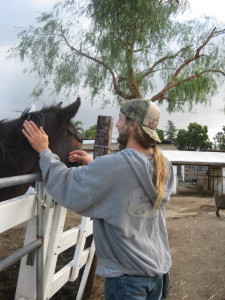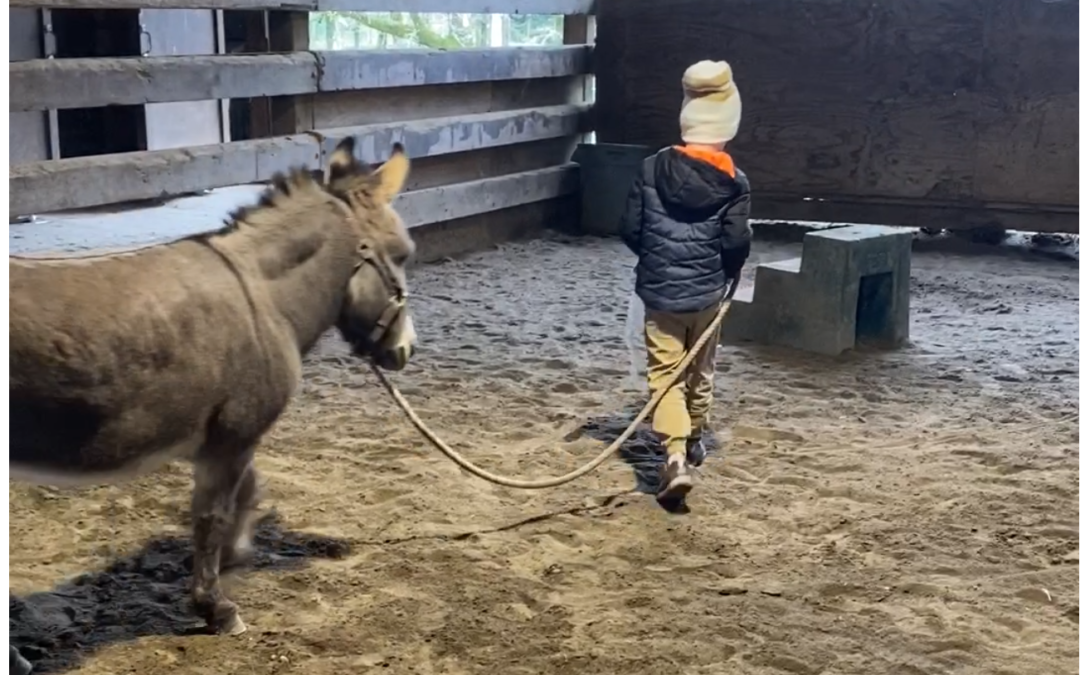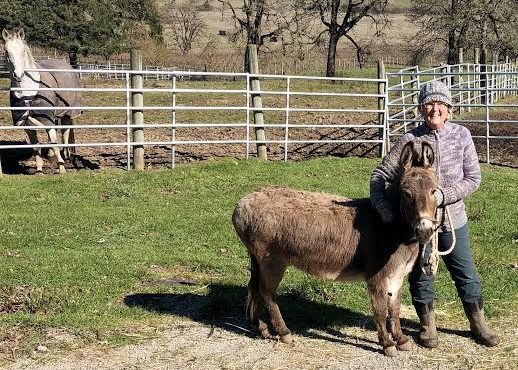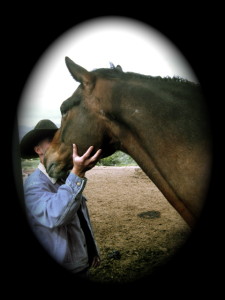The Newberg Graphic – Horse rescue farm sinking deep roots in Newberg (article)
As someone who feels she’s been healed by horses herself, Rose Sullivan jumped at the chance to get involved when she first learned about equine assisted psychotherapy (EAP) four years ago.
Sullivan was in Southern California at the time, but moved her nonprofit animal rescue and equine therapy farm to 17250 N.E. Lewis Rogers Lane just outside of Newberg in March 2013 to accommodate her growing operation.
Helping Hands Horse Rescue and Equine Therapy has been working with a local therapist and clients, but wanted to introduce itself to the community, which is why Sullivan is hosting a free Farm Day from 9 a.m. to 2 p.m. Aug. 23.
WHY HORSING AROUND IS GOOD FOR YOU:SPENDING TIME AROUND STABLES IS PROVEN TO REDUCE STRESS
BY EMMA INNES
- Children who spend time with horses have lower levels of stress hormones in their bodies.
- High levels of the stress hormone cortisol can cause health problems.
A study found that children who spend time with horses or riding have lower levels of stress hormones, according to measurements taken from their saliva.
Researchers looked at 130 teenagers taking part in an after school horsemanship course that lasted 12 weeks.
They spent 90 minutes a week learning about horses: how to care for, groom, handle, and ride the animals.
Each teenager gave six samples of saliva over a two day period before and after the 12 week programme.
Researchers analyzed the levels of the stress hormone cortisol in the samples
The results, published in the American Psychological Association’s Human-Animal Interaction Bulletin, revealed that children who spent time with horses had ‘significantly’ lower stress levels than a control group.
Dr. Patricia Pendry, from Washington State University, said: ‘We found that children who had participated in the 12-week program had significantly lower stress hormone levels throughout the day and in the afternoon, compared to children in the waitlisted group.
‘We get excited about that because we know that higher base levels of cortisol – particularly in the afternoon – are considered a potential risk factor for the development of psychopathology.’
Researchers hope the finding could help them develop new ways of preventing mental health problems in teenagers.
Researchers hope that the study could be a first step in finding ways to prevent teenagers developing mental health problems.
Previous studies have already found that interacting with dogs, horses and cats can be good for children as it improves their self-esteem.
However, the idea of horses reducing stress in adolescents has never before been studied.
Dr. Pendry said she hopes that horsemanship could be used as a form of therapy for people who have psychological problems.
‘We were coming at this from a prevention perspective,’ said Dr. Pendry.
‘We are especially interested in optimising healthy stress hormone production in young adolescents, because we know from other research that healthy stress hormone patterns may protect against the development of physical and mental health problems.
‘The beauty of studying stress hormones is that they can be sampled quite noninvasively and conveniently by sampling saliva in naturalistic settings as individuals go about their regular day.’
WHY EQUINE THERAPY WORK FOR EATING DISORDERS
By Claire Dorotik-Nana, LMFT
While the efficacy of equine therapy has been questioned, with critics challenging the field’s sparse research studies, another concern has been raised regarding the burgeoning practice of incorporating horses into mental health treatment models — and that is, just how does equine therapy work?
Unlike Cognitive-Behavioral Therapy, Family Systems Therapy, or DBT, equine therapy cannot always be clearly explained. Yes, we know that a horse is more approachable than another person for clients who suffer from social anxiety, and yes, we know that in general, spending time with animals has been linked to improved measures of mental health.
But these are largely assumptive explanations for why equine therapy may be a helpful, and efficacious form of treatment.
So lets look for a moment at the case of eating disorders where equine therapy has been widely used. Looking first at the National Eating Disorders Association definition of both Anorexia Nervosa and Bulimia Nervosa, we see that both disorders are characterized by an “extreme concern with body weight and shape”. Looking further into what constitutes this concern about body image, what becomes clear is that a person with an eating disorder has adopted appearance ideals into her internal definition of beauty and self, so much so that there is no room for any other objective definition of the self.
This is what as known as self-objectification.
The language goes something like this, “If I don’t look this certain way, I am completely and utterly worthless.”
However, one must also consider the source of this profound body shame. This internalized self destruction was at the hands of other people, whether it be through the media, family, friends, or life partners.
And so to now recover, the ED patient must trust the very hand that dealt her the shame in the first place. And for many who live in the profound hell of an eating disorder this is simply too much.
Enter equine therapy. For a person with ED, a horse does not carry the same potential for shame as does a person, yet at the same type offers the opportunity for a relationship. So while the horse represents an acceptance unlike any other for a person with ED, in order to have a relationship, he makes a few demands.
For a horse, when a person slips away from the relationship into the self (in order to engage in self objectification), the relationship process ceases, and so does his pursuit of it. The language would go something like this, “Yes I will accept you fully, unconditionally, but in order to have this relationship, you must be fully present.”
When the person is not fully present, and the horse moves away, temporarily halting the relationship, the disengagement on the part of the ED patient becomes vivid. This is an important observation for the person with an eating disorder, as often she may disengage so much and so frequently that even she is unaware that she is doing it or of the effect it is having on her relationships. And while the human relationships in an ED’s life may be the cause of much of her pain, their avoidance is also a hallmark feature of the disorder.
Making the case for equine therapy with an eating disorder patient then is like making the case for the rebuilding of the relationship — not just with the other but with the self as well

HORSE ASSISTED THERAPY HELPS RECOVERING ADDICTS
By Jill Sheridan
A group of men from a recovery house in Indianapolis are benefitting from a type of addiction therapy they’ve never tried before.
There are 11 therapy horses currently helping people at Agape Therapeutic Riding center in rural north central Indiana. The therapeutic benefits or working with animals is well documented in helping reduce stress, but working with horses is different. Equine-assisted therapy for addiction addresses skill development like improving communication, patience, self-confidence and assertiveness.
Agape program director Linda Hazard says for someone in recovery the work starts with stepping out of their comfort zone and taking first steps.
“You’re not going to change behavior overnight but what you’re going to change is to have them start thinking,” says Hazard. “How can I go about this in a little different manner, because that’s how you’re going to stay in recovery.”
Progress House in Indianapolis has been helping people in recovery for the past 50 years. Dennis Norris recently took over as executive director. He is also an Afghanistan war veteran. When he came home, he worked with horses.
“I was just an angry jerk, and if you’re an angry jerk with a 1,500 pound animal you’re going to have a really bad day. And I learned that very quickly,” says Norris. “So I learned to calm myself down, to trust myself. We all did it together.”
Norris immediately thought this type of program could help some of the residents at Progress House so he reached out to Agape and Hazard to see if they could start with 10 men.
“And she said that’s fine but we want 10 of your worst guys,” says Norris. “And I said ‘OK, but don’t be surprised if you get different guys every week because they’ll drop out.”
But that’s not what happened – all the original men are still with the program. Progress House program manager Rich Stover has been on the staff for three years after being a resident. He was arrested in 2012.
“I was a big time user,” remembers Stover. “I was caught with an amount of drugs they considered a dealing amount, but I considered a daily usage.”
He struck a plea deal and finished a drug recovery program at Progress House. He says his recovery was successful with the help of the people around him.
“The staff and the structure, and the men I lived here with. The unwritten asset here at Progress house is the residents,” says Stover.
The lesson is for this group of men — on week seven of the 16-week program at Agape — is teamwork. In the ring, the men are working with Duke and Smarty who have free reign. There’s no riding with this type of therapy. Instead, the men are given a task based on the skill they’re trying to develop. This week, Hazard has tasked them to move chosen objects, themselves and the horses from one side of the ring to the other without getting washed away in an imaginary river.
Bill Williamson is at Progress House for the third time and says this time working with the horses has really helped him.
“I’ve learned how to open up a lot more and the ability to use resources that we never thought we had and they’re right there in front of us the whole time,” Williamson says.
Resources like family, friends, therapy and support groups. Hazard says it can be eye-opening.
“It makes them sit back and think why am I doing certain things and what is the payback for not showing up and not taking risks,” says Hazard. “Because really once you answer those questions you can’t stay with your addiction.”
Join us for Farm Day 2024
\ Come join us for our annual community event and fundraiser: Farm Day 2024. Meet the Helping Hands therapy horses, and take part in one of our demos, where we show you how Equine Therapy works. From 10 to 1 we will be hosting tours of the Sanctuary, where you can...
Amazing Teambuilding event at Helping Hands Healing Sanctuary!!
Yesterday at Helping Hands Healing Sanctuary we helped facilitate a corporate teambuilding event for a local counseling group. Utilizing the horses, we helped them explore their goal to promote unity and growth for their team. They learned about trust, feeling safe to...
Spring is coming! Covid is slowing down! Excited for lots of good things coming!!!
Helping Hands Healing Sanctuary is hoping to resume our group therapy sessions by Summer 2021 if everything continues to go in the right direction. We will be offering group equine therapy sessions for the following groups: Adolescent girls ages 11-17 and adolescent...

Antea the donkey healing kids!!
Helping Hands Healing Sanctuary is a refuge for people and animals alike, needing love, security, healing and just a safe place to be. We take in animals in need of homes and give them a purpose. Just like humans, animals need to feel loved...

Longtime volunteer built our therapy goats this beautiful shelter (goatopia)
Gold Award Girl Scouts – Jessica Knight Jessica Knight is a recent Thousand Oaks High School graduate and avid animal lover. She’s spent the last six summers volunteering at the Helping Hands Healing Sanctuary farm in Newberg, Oregon, which specializes in...

Welcome ANTEA the miniature donkey!!
Hello sweet girl!!! Welcome Antea the miniature donkey! Antea comes to us from Malibu, California. She is a super sweet little girl and will be an invaluable addition to our equine therapy program. Here at Helping Hands Healing Sanctuary we provide Equine Therapy...
Helping Hands Healing Sanctuary to host Equine Therapy Fundamentals Training!!
Helping Hands Healing Sanctuary is proud to announce we are hosting a Equine Assisted Psychotherapy Fundamentals Training on May 1-5, 2019. If you are a Mental Health provider, or are a horse lover who has dreamed of using horses for healing, this will be an...
R.I.P. Roly Poly (our beloved therapy horse)
After years of service and helping many clients through hard times during our therapy sessions, we say goodbye to our beloved miniature horse, Roly. May you cross the rainbow bridge and gallop through the green fields of horsie heaven with Cavalia, Mistery, Star,...
Farm Day was a huge success!! A big thank you to all our volunteers that made this event such a special day!
In the quiet is the stillness………..a stillness that you can find only if you take the time to experience it.
Come to our 4th Annual Farm Day Event on August 4th, 2018!!! Visit with the horses, experience equine therapy to understand how it works and see our healing menagerie of farm animals!
Group Therapy sessions are now available with the horses every Saturday!! See below to sign up!! We have a addiction /recovery group, an adolescent group, and a group for those suffering from anxiety/depression.
Therapy Horses come in all sizes and colors: meet Teddy our newest addition.
SEEN HERE IS VERONICA, ONE OF OUR LONGTIME VOLUNTEERS GETTING HER DOSE OF BABY LOVE.
RIP Sweet Darla, our oldest and sweetest therapy goat loved by so many.
It is with a heavy heart I want to announce the passing of our oldest and sweetest therapy goat, Darla. For the last 20 years Darla has been giving all of herself and smiling at those who needed love and comfort. Darla has showed us an incredible will to live after...
Local 4 H kids and their parents volunteer at Helping Hands!!!!
Newberg Sail Program volunteers come help and visit the animals at our Healing Sanctuary
WE WANT TO THANK ALL THE STAFF AND VOLUNTEERS FROM THE NEWBERG SAIL PROGRAM FOR ALL THE WONDERFUL HELP AND CUDDLES THEY GIVE OUR ANIMALS!
3RD ANNUAL FARM DAY EVENT COMING UP!
COME JOIN US FOR LOTS OF FUN WITH THE HORSES AND ANIMALS ON SATURDAY JULY 29!! Click on picture to view larger!
ANIMALS HELP US CONNECT!
Animals help us connect. Like a mother with her young piglets and a mare with her foal, we too can connect with animals. In life, it's sometimes hard for us to feel connected to others because we have isolated ourselves for a long time. We may have learned and thought...
A beautiful rainbow on a quiet day at our healing sanctuary!
Solitude.....many of us are strongly attached to activity and people. We crave stimulation, entertainment, movement, and don't like being alone.....To find peace and spiritual vitality we must seek the quiet in stillness. In solitude you can learn to face yourself...
New Arrival at Helping Hands!!!
Welcome to the world little girl! Have you ever wondered what it must be like to be seeing everything new for the first time? That's what it's like for a baby horse, but also what it's like for those of you early in your recovery. In a way, it is like being born all...

Welcome to our Healing Farm!
Welcome to Helping Hands Horse Rescue and Equine Therapy Inc. a 501-c-3 non-profit organization! Our "healing" sanctuary is located in the midst of the Chehalem mountains, in beautiful Newberg,Oregon, on 20 rolling acres, in a beautiful pastoral setting we call...


